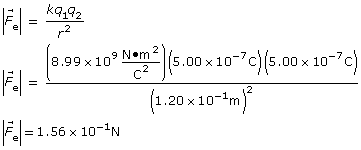Module 3
1. Module 3
1.19. Page 3
Module 3—Electrical Phenomena
Calculations with Coulomb’s Law
Dealing with Signs of Charges

© digitalife/shutterstock
![]()
The force of gravity is always an attracting force, acting to pull one mass toward another. In the previous photo, Earth is attracted to the sun.

![]()
The electrostatic force can be an attracting force or a repelling force, depending upon the sign of the charges. In the previous photo, balloon 1 repels balloon 2, since each balloon has a negative charge.
It is truly remarkable that two of the most fundamental laws in physics, which describe completely different phenomena and are based on completely different observations, should be so similar. The reasons for these similarities remain a mystery. However, it would be misleading to say that these forces are identical because there are some important differences.
When you solve problems with Coulomb’s law, it is important to substitute only the magnitude of the charges into the equation. The signs of the charges are considered after the calculation is complete to determine the direction of the resulting force.
 Read
Read
Do “Example 10.1” on page 530 in your textbook.
 Self-Check
Self-Check
Use this question to confirm your understanding of example 10.1.
SC 3. Complete the “Practice Problem” on page 530 of your textbook.
 Self-Check Answers
Self-Check Answers
SC 3.
Given

Required
![]()
Analysis and Solution
![]()

Note that the signs of the charges were not substituted into the equation.
![]()
![]() [attraction], since opposite charges attract
[attraction], since opposite charges attract
Paraphrase
The electrostatic force of 8.22 × 10−8 N pulls the electron toward the proton. This same force pulls the proton toward the electron.
Calculations with Coulomb’s Law
Using the Law of Conservation of Charge
Sometimes the law of conservation of charge plays a role in Coulomb’s law calculations. The two objects with different charges are first touched together and then separated before an electrostatic force is calculated.
 Read
Read
Do “Example 10.2” on page 531 of your textbook.
 Self-Check
Self-Check
Use this question to confirm your understanding of example 10.2.
SC 4. Complete the “Practice Problem” on page 531 of your textbook.
 Self-Check Answers
Self-Check Answers
SC 4.
Given

Required
![]()
Analysis and Solution
Step 1: Determine the charge on each sphere after they touch.
Apply the law of conservation of charge to the system of the two spheres:
total charge after touching = total charge before touching

Since the total charge after the spheres touch is divided equally between the two identical spheres

Step 2: Determine the electrostatic force acting on each sphere.

![]() [repulsion], since like charges repel
[repulsion], since like charges repel
Paraphrase
The electrostatic force of 1.56 × 10–1 N acts on sphere 1 and pushes it away from sphere 2. The same force acts on sphere 2, pushing it away from sphere 1.
 Module 3: Lesson 3 Assignment
Module 3: Lesson 3 Assignment
Remember to submit your answer to A 1 as part of your Module 3: Lesson 3 Assignment to your teacher for marks.
A 1. Answer question 12 on page 540 of your textbook.